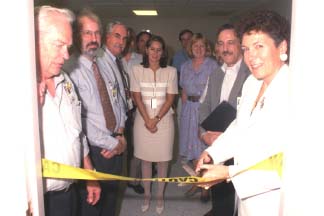

|
5 February 1999, Volume 22, Number 3 |
The Defense Advanced Research Projects Agency (DARPA) Information Technology Office (ITO) has tasked SSC San Diego to establish DARPA's Crisis/Consequence Management Laboratory. The ITO needs an evaluation environment that would test the value of enhanced situational awareness in realistic scenarios, such as an attack with weapons of mass destruction (WMD). The Crisis/Consequence Management Laboratory looks at newly emerging technologies being developed under ITO's information management (IM) program.
One of these, GeoWorlds98, was contracted with the University of Southern California Information Sciences Institute. GeoWorlds98 is designed to enhance situational awareness through integration of multiple sources of information to extract relevant information. It abstracts the information into semantic units in a timely manner and offers consistency across diverse information sources.
Last year SSC San Diego established a cross-departmental team led by Dr. Brenda-Lee Karasik from the Office of the Deputy Technical Director for Science, Technology and Engineering (D10). Representatives from the technical codes investigated how SSC San Diego expertise in integrating information systems could be applied to the mission of countering terrorist attacks involving WMD. This involved a comprehensive study of the Federal Response Plan (FRP), Presidential Decision Directives, plus interviews with policy makers and many of the 29 agencies with roles in preparing the nation for newly perceived threats.
One result of the team's effort was a Memorandum of Understanding (MOU) with the Federal Emergency Management Association (FEMA). This MOU allows SSC San Diego to transfer technologies and provide supporting technological solutions to the emergency management community. It extends the scope of working with emergency managers beyond the local community and provides greater opportunities to integrate information systems to tactical, regional, command, national, or strategic levels. On Oct. 12, 1998 Dr. Karasik led members of the cross-departmental team in a ribbon-cutting ceremony for the EOC emulation complex in Building A35.
It was designated as the Crisis/Consequence Management Laboratory by DARPA ITO program manager Dr. Ron Larsen. Hal Holmerud, Satellite Communications Systems Branch (D844), is the project lead with support from John Moore, Occupational Safety Support Group (D0383); Chris Von-Mueller, Integrated Voice Communications Systems Branch (D633); Steve Kennison, Test and Evaluation Branch (D7212); David Teed, Intelligence Systems (D73C); and Cecil Waterhouse, Radio Frequency Networks Branch (D824). Help was provided from other technical departments when required.
The lab has a Windows NT server, six client workstations, a large screen projection display, an electronic camera, scanner, and printer support for business operations. An initial remote access from the Commander, Navy Region Southwest, Regional Planning Agent (RPA) will evaluate new technologies. These will support planning, coordinating, and executing emergency management and emergency response functions for commands within the Navy Region Southwest area of responsibility.

At the Ribbon Cutting Ceremony, Oct. 12, Dr. Brenda Lee Karasik (r), CMIPT leader, prepares to wield the scissors while Hal Holmerud (l), GeoWorlds98 project lead, looks on. Other visible members of the CMIPT celebrating are David Lowenstein, D7305; Dale Gurley, D14; Sharon Pritchard, D212, Aleta Wallace, D14; and Dr. George Seymour, D44210.

David Teed (far right) explains the use of modeling and simulation capabilities to members of the team for poisonous gas plume forecasting